Linksys WRT160N User Manual

USER GUIDE
Wireless-N Broadband Router
Model: WRT160N

About This Guide
About This Guide
Icon Descriptions
While reading through the User Guide you may see various icons that call attention to specific items. Below is a description of these icons:
NOTE: This check mark indicates that there is a note of interest and is something that you should pay special attention to while using the product.
WARNING: This exclamation point indicates that there is a caution or warning and it is something that could damage your property or product.
WEB: This globe icon indicates a noteworthy website address or e-mail address.
Online Resources
Website addresses in this document are listed without http:// in front of the address because most current web browsers do not require it. If you use an older web browser, you may have to add http:// in front of the web address.
Resource |
Website |
|
|
Linksys |
www.linksys.com |
|
|
Linksys International |
www.linksys.com/international |
|
|
Glossary |
www.linksys.com/glossary |
|
|
Network Security |
www.linksys.com/security |
|
|
Copyright and Trademarks
Linksys, Cisco and the Cisco Logo are registered trademarks or trademarks of Cisco Systems, Inc. and/or its affiliates in the U.S. and certain other countries. Copyright © 2009 Cisco Systems, Inc. All rights reserved. Other brands and product names are trademarks or registered trademarks of their respective holders.
Wireless-N Broadband Router |
i |

Table of Contents
Chapter 1: Product Overview |
|
|
|
4 |
Front Panel |
|
|
|
4 |
Back Panel . . . . . . . . . . . . . . . . . . . . |
. . . . . . . . |
. . . . |
. |
. 4 |
Placement Positions |
|
|
|
4 |
Chapter 2: Wireless Security Checklist |
|
|
|
6 |
General Network Security Guidelines |
|
|
|
6 |
Additional Security Tips . . . . . . . . . . . . . . |
. . . . . . . . |
. . . . |
. |
. 6 |
Chapter 3: Advanced Configuration |
|
|
|
7 |
Setup > Basic Setup . . . . . . . . . . . . . . . . |
. . . . . . . . |
. . . . |
. |
. 7 |
Setup > DDNS |
|
|
|
11 |
Setup > MAC Address Clone |
|
|
|
12 |
Setup > Advanced Routing . . . . . . . . . . . . |
. . . . . . . . |
. . . . |
. . |
12 |
Wireless > Basic Wireless Settings . . . . . . . . . . |
. . . . . . . . |
. . . . |
. |
13 |
Wireless > Wireless Security . . . . . . . . . . . . |
. . . . . . . . |
. . . . |
. . |
14 |
Wireless > Wireless MAC Filter |
|
|
|
16 |
Wireless > Advanced Wireless Settings . . . . . . . . |
. . . . . . . . |
. . . . |
. |
17 |
Security > Firewall . . . . . . . . . . . . . . . . |
. . . . . . . . |
. . . . |
. . |
18 |
Security > VPN Passthrough |
|
|
|
18 |
Access Restrictions > Internet Access . . . . . . . . |
. . . . . . . . |
. . . . |
. . |
19 |
Applications and Gaming > Single Port Forwarding |
|
|
|
20 |
Applications and Gaming > Port Range Forwarding . . |
. . . . . . . . |
. . . . |
. |
21 |
Applications & Gaming > Port Range Triggering . . . . . . . . . . . . . . . . . . . . . . . . . .21 |
||||
Applications and Gaming > DMZ . . . . . . . . . . |
. . . . . . . . |
. . . . |
. |
22 |
Applications and Gaming > QoS . . . . . . . . . . |
. . . . . . . . |
. . . . |
. . |
22 |
Administration > Management |
|
|
|
24 |
Administration > Log . . . . . . . . . . . . . . . |
. . . . . . . . |
. . . . |
. |
.25 |
Administration > Diagnostics . . . . . . . . . . . . |
. . . . . . . . |
. . . . |
. |
26 |
Administration > Factory Defaults |
|
|
|
26 |
Administration > Firmware Upgrade . . . . . . . . |
. . . . . . . . |
. . . . |
. . |
27 |
Status > Router . . . . . . . . . . . . . . . . . . |
. . . . . . . . |
. . . . |
. |
27 |
Status > Local Network . . . . . . . . . . . . . . |
. . . . . . . . |
. . . . |
. . |
27 |
Status > Wireless Network . . . . . . . . . . . . . |
. . . . . . . . |
. . . . |
. |
.28 |
Appendix A: Troubleshooting |
|
|
|
29 |
Appendix B: Specifications |
|
|
|
30 |
Appendix C: Warranty Information |
|
|
|
31 |
Limited Warranty |
|
|
|
31 |
Exclusions and Limitations |
|
|
|
31 |
Obtaining Warranty Service . . . . . . . . . . . . |
. . . . . . . . |
. . . . |
. . |
31 |
Technical Support . . . . . . . . . . . . . . . . |
. . . . . . . . |
. . . . |
. . |
32 |
Wireless-N Broadband Router |
ii |

Table of Contents
Appendix D: Regulatory Information |
|
33 |
FCC Statement . . . . . . . . . . . . . . . . . . . . . . . . . . . . . . |
. |
33 |
FCC Radiation Exposure Statement . . . . . . . . . . . . . . . . . . . . . |
. |
.33 |
Safety Notices |
|
33 |
Industry Canada Statement . . . . . . . . . . . . . . . . . . . . . . . . |
. . |
33 |
Avis d’Industrie Canada |
|
34 |
Wireless Disclaimer . . . . . . . . . . . . . . . . . . . . . . . . . . . . |
. |
34 |
Avis de non-responsabilité concernant les appareils sans fil . . . . . . . . . . |
. . |
34 |
User Information for Consumer Products Covered by EU Directive 2002/96/EC on Waste |
||
Electric and Electronic Equipment (WEEE) |
|
35 |
Appendix E: Software End User License Agreement |
|
39 |
Cisco Products . . . . . . . . . . . . . . . . . . . . . . . . . . . . . . |
. |
39 |
Software Licenses . . . . . . . . . . . . . . . . . . . . . . . . . . . . |
. . |
39 |
Wireless-N Broadband Router |
iii |
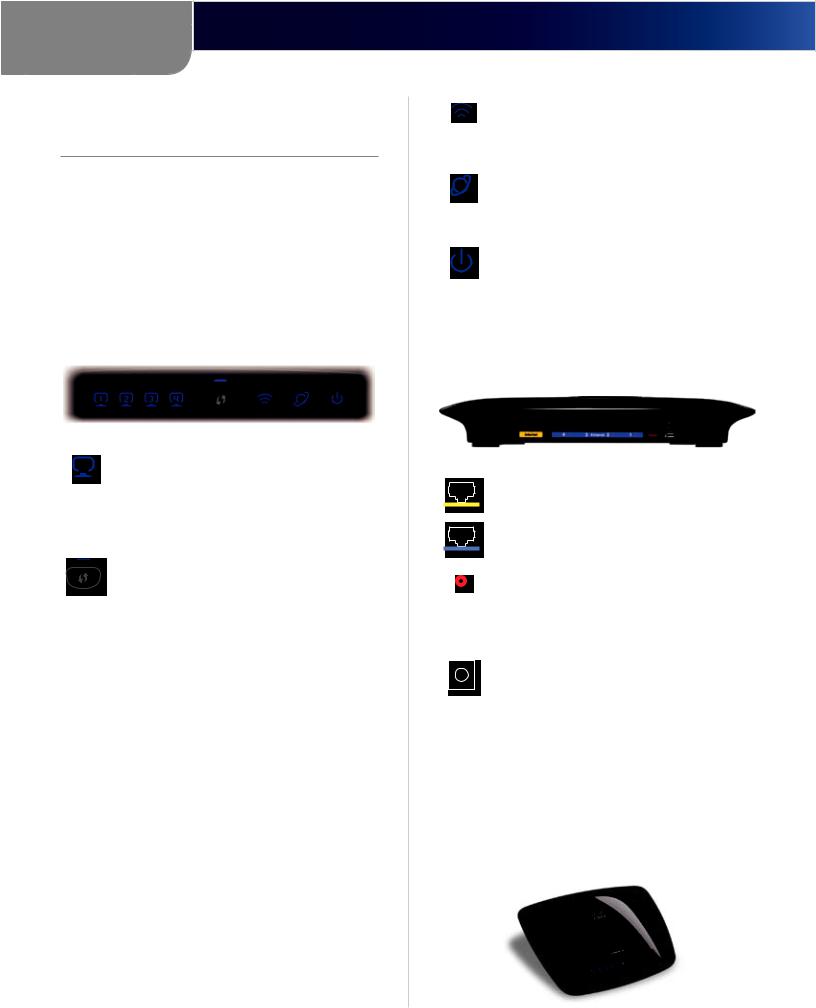
Chapter 1
Product Overview
Chapter 1:
Product Overview
Thank you for choosing the Linksys Wireless-N Broadband Router. The Router lets you access the Internet via a wireless connection or through one of its four switched ports. You can also use the Router to share resources, such as computers. A variety of security features help to protect your data and your privacy while online. Security features include WPA2 security, a Stateful Packet Inspection (SPI) firewall and NAT technology. Configuring the Router is easy using the provided browser-based utility.
Front Panel
1, 2, 3, 4 (Green/Blue) These numbered LEDs, corresponding with the numbered ports on the Router’s back panel, serve two purposes. The LED is solidly lit when the Router is connected to a device through that port. It flashes to indicates network activity.
Wi-Fi Protected Setup Button If you have client devices, such as wireless adapters, that support Wi-Fi Protected Setup, then you can use Wi-Fi Protected Setup to automatically configure wireless security for your wireless network(s).
To use Wi-Fi Protected Setup, run the Setup Wizard, or refer to the “Wireless > Basic Wireless Settings” section of “Chapter 3: Advanced Configuration”.
Wi-Fi Protected Setup LED (Blue/Amber) It lights up blue when wireless security is enabled. The LED flashes blue for two minutes during Wi-Fi Protected Setup.
The LED lights up amber if there is an error during the Wi Fi Protected Setup process. Make sure the client device supports Wi Fi Protected Setup.WaituntiltheLEDisoff,andthentryagain.
The LED flashes amber when a Wi Fi Protected Setup session is active, and a second session begins. The Router supports one session at a time. Wait until the LED is off before starting the next Wi-Fi Protected Setup session.
Wireless (Blue) The Wireless LED lights up when the wireless feature is enabled. If the LED is flashing, the Router is actively sending or receiving data over the network.
Internet (Blue) The Internet LED lights up when there is a connection made through the Internet port. A flashing LED indicates network activity over the Internet port.
Power (Blue) The Power LED lights up and will stay on while the Router is powered on. When the Router goes through its self-diagnostic mode during every boot-up, this LED will flash. When the diagnostic is complete, the LED will be solidly lit.
Back Panel
Internet This port is where you will connect your cable or DSL Internet connection.
4, 3, 2, 1 These ports (4, 3, 2, 1) connect the Router to computers and other Ethernet network devices on your wired network.
Reset There are two ways to reset the Router’s factory defaults. Either press and hold the Reset Button for approximately five seconds, or restore the defaults from Administration > Factory Defaults in the Router’s web-based utility.
Power The Power port is where you will connect the power adapter.
Placement Positions
There are two ways to physically install the Router. The first way is to place the Router horizontally on a surface. The second way is to mount the Router on a wall.
Horizontal Placement
The Router has four rubber feet on its bottom panel. Place the Router on a level surface near an electrical outlet.
Wireless-N Broadband Router |
4 |
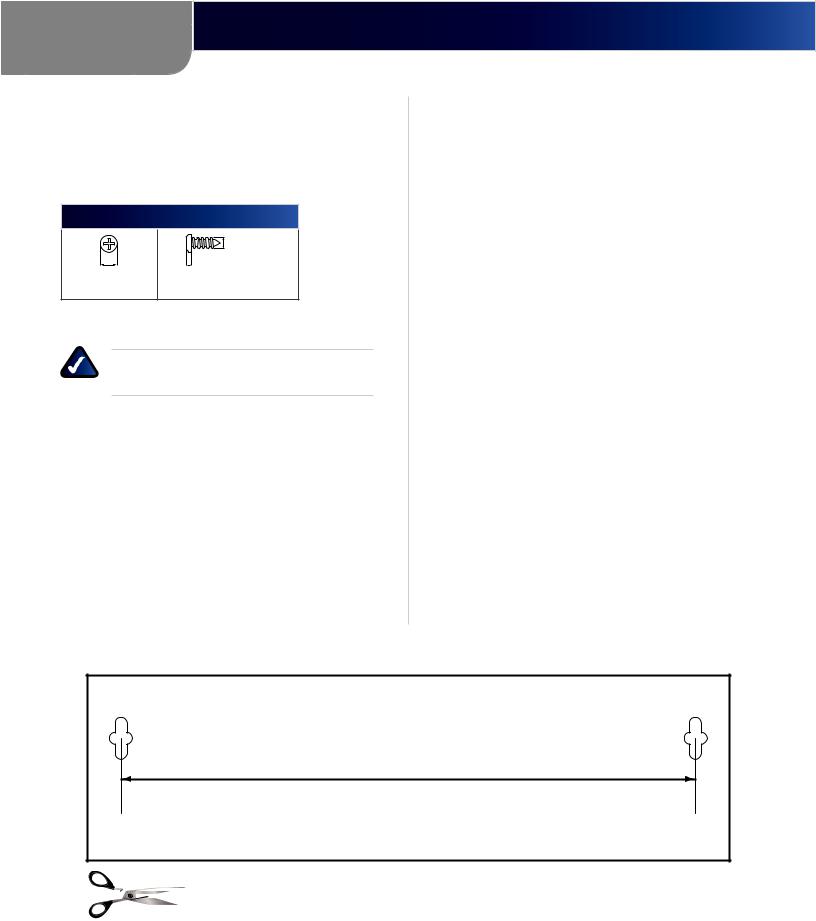
Chapter 1
Wall-Mounting Placement
The Router has two wall-mount slots on its bottom panel. The distance between the slots is 152 mm (6 inches).
Two screws are needed to mount the Router.
Suggested Mounting Hardware
4-5 mm |
1-1.5 mm |
-3.0 mm |
|
2.5 |
|||
|
|
††Note: Mounting hardware illustrations are not true to scale.
NOTE: Linksys is not responsible for damages incurred by insecure wall-mounting hardware.
Product Overview
Follow these instructions:
1.Determine where you want to mount the Router. Make sure that the wall you use is smooth, flat, dry, and sturdy. Also make sure the location is within reach of an electrical outlet.
2.Drill two holes into the wall. Make sure the holes are 152 mm (6 inches) apart.
3.Insert a screw into each hole and leave 3 mm (0.12 inches) of its head exposed.
4.Maneuver the Router so the wall-mount slots line up with the two screws.
5.Place the wall-mount slots over the screws and slide the Router down until the screws fit snugly into the wall-mount slots.
152 mm
Print this page at 100% size.
Cut along the dotted line, and place on the wall to drill precise spacing.
Wall Mounting Template
Wireless-N Broadband Router |
5 |

Chapter 2
Wireless Security Checklist
Chapter 2:
Wireless Security Checklist
Wireless networks are convenient and easy to install, so homes with high-speed Internet access are adopting them at a rapid pace. Because wireless networking operates by sending information over radio waves, it can be more vulnerable to intruders than a traditional wired network. Like signals from your cellular or cordless phones, signals from your wireless network can also be intercepted. Since you cannot physically prevent someone from connecting to your wireless network, you need to take some additional steps to keep your network secure.
1.Change the default wireless network name or SSID
Wireless devices have a default wireless network name or Service Set Identifier (SSID) set by the factory. This is the name of your wireless network, and can be up to 32 characters in length. Linksys wireless products use linksys as the default wireless network name. You should change the wireless network name to something unique to distinguish your wireless network from other wireless networks that may exist around you, but do not use personal information (such as your Social Security number) because this information may be available for anyone to see when browsing for wireless networks.
 2. Change the default password
2. Change the default password
For wireless products such as access points and routers, you will be asked for a password when you want to change their settings. These devices have a default password set by the factory. The Linksys default password is admin. Hackers know these defaults and may try to use them to access your wireless device and change your network settings. To thwart any unauthorized changes, customize the device’s password so it will be hard to guess.
 3. Enable MAC address filtering
3. Enable MAC address filtering
Linksys routers give you the ability to enable Media Access Control (MAC) address filtering. The MAC address is a unique series of numbers and letters assigned to every networking device. With MAC address filtering enabled, wireless network access is provided solely for wireless devices with specific MAC addresses. For example, you can specify the MAC address of each computer in your home so that only those computers can access your wireless network.
 4. Enable encryption
4. Enable encryption
Encryption protects data transmitted over a wireless network. Wi-Fi Protected Access (WPA/WPA2) and Wired Equivalent Privacy (WEP) offer different levels of security for wireless communication.
A network encrypted with WPA/WPA2 is more secure than a network encrypted with WEP, because WPA/WPA2 uses dynamic key encryption. To protect the information as it passes over the airwaves, you should enable the highest level of encryption supported by your network equipment.
WEP is an older encryption standard and may be the only option available on some older devices that do not support WPA.
General Network Security Guidelines
Wireless network security is useless if the underlying network is not secure.
•• Password protect all computers on the network and individually password protect sensitive files.
•• Change passwords on a regular basis.
•• Install anti-virus software and personal firewall software.
•• Disable file sharing (peer-to-peer). Some applications may open file sharing without your consent and/or knowledge.
Additional Security Tips
•• Keep wireless routers, access points, or gateways away from exterior walls and windows.
•• Turn wireless routers, access points, or gateways off when they are not being used (at night, during vacations).
•• Usestrongpassphrasesthatareatleasteightcharacters in length. Combine letters and numbers to avoid using standard words that can be found in the dictionary.
WEB: For more information on wireless security, visit www.linksys.com/security
Wireless-N Broadband Router |
6 |
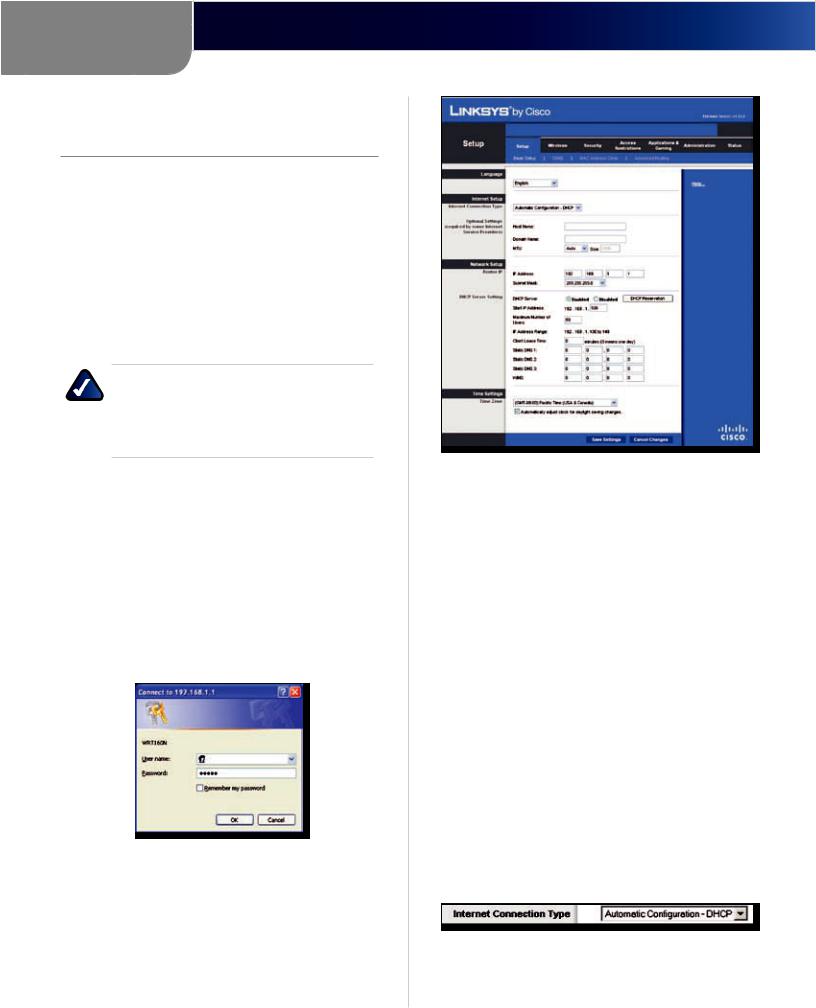
Chapter 3
Advanced Configuration
Chapter 3:
Advanced Configuration
After setting up the Router with the Setup Wizard (located on the CD-ROM), the Router will be ready for use. However, if you’d like to change its advanced settings, use the Router’s web-based utility. This chapter describes each web page of the utility and each page’s key functions. You can access the utility via a web browser on a computer connected to the Router.
The web-based utility has these main tabs: Setup, Wireless, Security, Access Restrictions, Applications & Gaming, Administration, and Status. Additional tabs will be available after you click one of the main tabs.
NOTE: When first installing the Router, you should use the Setup Wizard on the Setup CD-ROM. If you want to configure advanced settings, use this chapter to learn about the web-based utility.
How to Access the Web-Based Utility
To access the web-based utility, launch the web browser on your computer, and enter the Router’s default IP address, 192.168.1.1, in the Address field. Then, press Enter.
A login screen will appear. (Non-Windows XP users will see a similar screen.) Leave the User name field blank. The first time you open the Web-based utility, use the default password admin. (You can set a new password from the Administration tab’s Management screen.) Click OK to continue.
Login Screen
Setup > Basic Setup
The first screen that appears is the Basic Setup screen. This allows you to change the Router’s general settings.
Setup > Basic Setup
Internet Setup
The Internet Setup section configures the Router to your Internet connection. Most of this information can be obtained through your ISP.
Internet Connection Type
Select the type of Internet connection your ISP provides from the drop-down menu. These are the available types:
•• Automatic Configuration - DHCP
•• Static IP
•• PPPoE
•• PPTP
•• L2TP
•• Telstra Cable
Automatic Configuration - DHCP
By default, the Router’s Internet Connection Type is set to Automatic Configuration - DHCP, which should be kept only if your ISP supports DHCP or you are connecting through a dynamic IP address. (This option usually applies to cable connections.)
Internet Connection Type > Automatic Configuration - DHCP
Wireless-N Broadband Router |
7 |
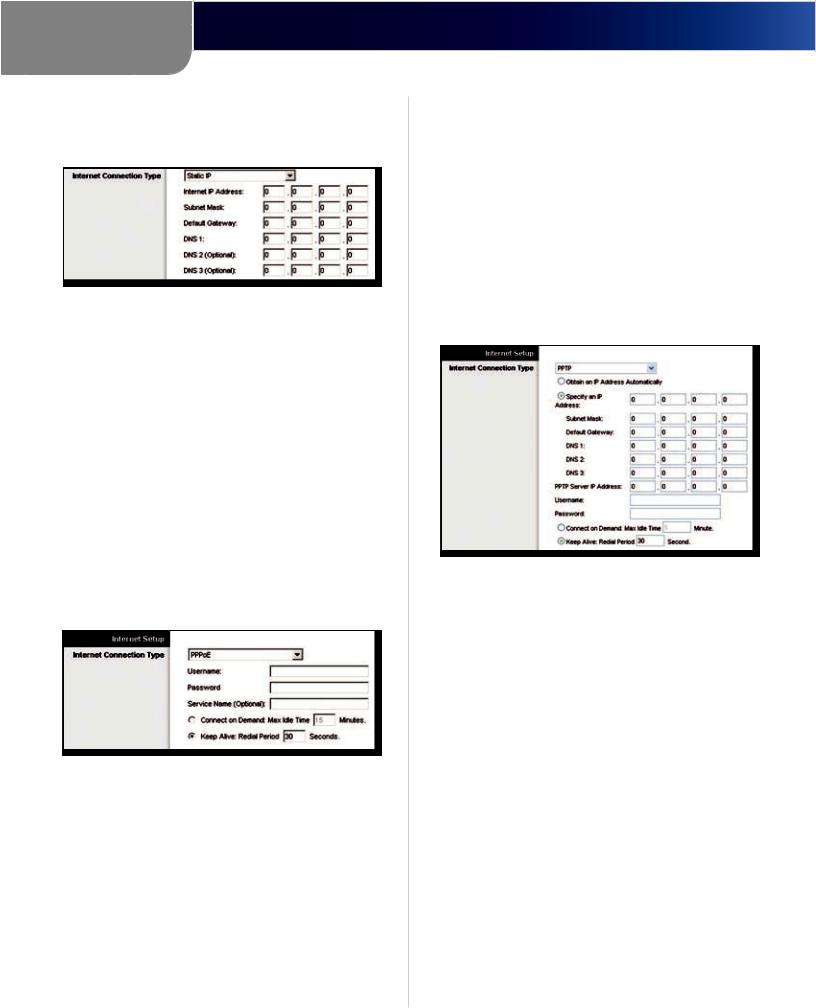
Chapter 3
Advanced Configuration
Static IP
If you are required to use a permanent IP address to connect to the Internet, select Static IP.
Internet Connection Type > Static IP
Internet IP Address This is the Router’s IP address, when seen from the Internet. Your ISP will provide you with the IP Address you need to specify here.
Subnet Mask This is the Router’s Subnet Mask, as seen by users on the Internet (including your ISP). Your ISP will provide you with the Subnet Mask.
Default Gateway Your ISP will provide you with the IP address of the ISP server.
DNS 1-3 Your ISP will provide you with at least one DNS (Domain Name System) server IP address.
PPPoE
Some DSL-based ISPs use PPPoE (Point-to-Point Protocol over Ethernet) to establish Internet connections. If you are connected to the Internet through a DSL line, check with your ISP to see if they use PPPoE. If they do, you will have to enable PPPoE.
Internet Connection Type > PPPoE
Username and Password Enter the Username and Password provided by your ISP.
Service Name If provided by your ISP, enter the Service Name.
Connect on Demand: Max Idle Time You can configure the Router to cut the Internet connection after it has been inactive for a specified period of time (Max Idle Time). If your Internet connection has been terminated due to inactivity, Connect on Demand enables the Router to automatically re-establish your connection as soon as you attempt to access the Internet again. To use this option, select Connect on Demand. In the Max Idle Time field, enter the number of minutes you want to have elapsed
before your Internet connection terminates. The default Max Idle Time is 15 minutes.
Keep Alive: Redial Period If you select this option, the Router will periodically check your Internet connection. If you are disconnected, then the Router will automatically re-establish your connection. To use this option, select Keep Alive. In the Redial Period field, you specify how often you want the Router to check the Internet connection. The default Redial Period is 30 seconds.
PPTP
Point-to-Point Tunneling Protocol (PPTP) is a service that applies to connections in Europe only.
Internet Connection Type > PPTP
If your ISP supports DHCP or you are connecting through a dynamic IP address, then select Obtain an IP Address Automatically. If you are required to use a permanent IP address to connect to the Internet, then select Specify an IP Address. Then configure the following:
•• Specify an IP Address This is the Router’s IP address, as seen from the Internet. Your ISP will provide you with the IP Address you need to specify here.
•• Subnet Mask This is the Router’s Subnet Mask, as seen by users on the Internet (including your ISP). Your ISP will provide you with the Subnet Mask.
•• Default Gateway Your ISP will provide you with the IP address of the ISP server.
•• DNS 1-3 Your ISP will provide you with at least one DNS (Domain Name System) server IP address.
PPTP Server IP Address Your ISP will provide you with the IP address of the PPTP server.
Username and Password Enter the Username and Password provided by your ISP.
Connect on Demand: Max Idle Time You can configure the Router to cut the Internet connection after it has been inactive for a specified period of time (Max Idle Time). If your Internet connection has been terminated due to
Wireless-N Broadband Router |
8 |

Chapter 3
Advanced Configuration
inactivity, Connect on Demand enables the Router to automatically re-establish your connection as soon as you attempt to access the Internet again. To use this option, select Connect on Demand. In the Max Idle Time field, enter the number of minutes you want to have elapsed before your Internet connection terminates. The default Max Idle Time is 15 minutes.
Keep Alive: Redial Period If you select this option, the Router will periodically check your Internet connection. If you are disconnected, then the Router will automatically re-establish your connection. To use this option, select Keep Alive. In the Redial Period field, you specify how often you want the Router to check the Internet connection. The default value is 30 seconds.
L2TP
L2TP is a service that applies to connections in Israel only.
Internet Connection Type > L2TP
Server IP Address This is the IP address of the L2TP Server. Your ISP will provide you with the IP Address you need to specify here.
Username and Password Enter the Username and Password provided by your ISP.
Connect on Demand: Max Idle Time You can configure the Router to cut the Internet connection after it has been inactive for a specified period of time (Max Idle Time). If your Internet connection has been terminated due to inactivity, Connect on Demand enables the Router to automatically re-establish your connection as soon as you attempt to access the Internet again. To use this option, select Connect on Demand. In the Max Idle Time field, enter the number of minutes you want to have elapsed before your Internet connection terminates. The default Max Idle Time is 15 minutes.
Keep Alive: Redial Period If you select this option, the Router will periodically check your Internet connection. If you are disconnected, then the Router will automatically re-establish your connection. To use this option, select Keep Alive. In the Redial Period field, you specify how often you want the Router to check the Internet connection. The default Redial Period is 30 seconds.
Telstra Cable
Telstra Cable is a service that applies to connections in Australia only.
Internet Connection Type > Telstra Cable
Server IP Address This is the IP address of the Heartbeat Server. Your ISP will provide you with the IP Address you need to specify here.
Username and Password Enter the Username and Password provided by your ISP.
Connect on Demand: Max Idle Time You can configure the Router to cut the Internet connection after it has been inactive for a specified period of time (Max Idle Time). If your Internet connection has been terminated due to inactivity, Connect on Demand enables the Router to automatically re-establish your connection as soon as you attempt to access the Internet again. To use this option, select Connect on Demand. In the Max Idle Time field, enter the number of minutes you want to have elapsed before your Internet connection terminates. The default Max Idle Time is 15 minutes.
Keep Alive: Redial Period If you select this option, the Router will periodically check your Internet connection. If you are disconnected, then the Router will automatically re-establish your connection. To use this option, select Keep Alive. In the Redial Period field, you specify how often you want the Router to check the Internet connection. The default Redial Period is 30 seconds.
Optional Settings
Some of these settings may be required by your ISP. Verify with your ISP before making any changes.
Optional Settings
Host Name and Domain Name These fields allow you to supply a host and domain name for the Router. Some ISPs, usually cable ISPs, require these names as identification. You may have to check with your ISP to see if your broadband Internet service has been configured with a
Wireless-N Broadband Router |
9 |

Chapter 3
Advanced Configuration
host and domain name. In most cases, leaving these fields blank will work.
MTU MTU is the Maximum Transmission Unit. It specifies the largest packet size permitted for Internet transmission. Select Manual if you want to manually enter the largest packet size that is transmitted. To have the Router select the best MTU for your Internet connection, keep the default setting, Auto.
Size When Manual is selected in the MTU field, this option is enabled. Leave this value in the 1200 to 1500 range. The default size depends on the Internet Connection Type:
•• DHCP, Static IP, or Telstra: 1500
•• PPPoE: 1492
•• PPTP or L2TP: 1460
Network Setup
The Network Setup section changes the settings on the network connected to the Router’s Ethernet ports.Wireless setup is performed through the Wireless tab.
Router IP
This presents both the Router’s IP Address and Subnet Mask as seen by your network.
Router IP
DHCP Server Setting
The settings allow you to configure the Router’s Dynamic Host Configuration Protocol (DHCP) server function. The Router can be used as a DHCP server for your network. A DHCP server automatically assigns an IP address to each computer on your network. If you choose to enable the Router’s DHCP server option, make sure there is no other DHCP server on your network.
DHCP Server Setting
DHCP Server DHCP is enabled by factory default. If you already have a DHCP server on your network, or you don’t want a DHCP server, then select Disabled (no other DHCP features will be available).
DHCP Reservation Click this button if you want to assign a fixed local IP address to a MAC address.
DHCP Reservation
You will see a list of DHCP clients with the following information: Client Name, Interface, IP Address, and MAC Address.
DHCP Reservation
•• Select Clients from DHCP Table Click the Select check box to reserve a client’s IP address. Then click
Add Clients.
•• Manually Adding Client To manually assign an IP address, enter the client’s name in the Enter Client Name field. Enter the IP address you want it to have in the Assign IP Address field. Enter its MAC address in the
To This MAC Address field. Then click Add.
Clients Already Reserved
A list of DHCP clients and their fixed local IP addresses will be displayed at the bottom of the screen. If you want to remove a client from this list, click Remove.
Click Save Settings to apply your changes, or click Cancel Changes to cancel your changes. To view the most up-to-date information, click Refresh. To exit this screen, click Close.
Start IP Address Enter a value for the DHCP server to start with when issuing IP addresses. Because the Router’s default IP address is 192.168.1.1, the Start IP Address must be 192.168.1.2 or greater, but smaller than 192.168.1.253. The default Starting IP Address is 192.168.1.100.
Maximum Number of Users Enter the maximum number of PCs that you want the DHCP server to assign IP addresses to. This number cannot be greater than 253. The default is 50.
IP Address Range Displayed here is the range of available IP addresses.
Client Lease Time The Client Lease Time is the amount of time a network user will be allowed connection to the Router with their current dynamic IP address. Enter the
Wireless-N Broadband Router |
10 |
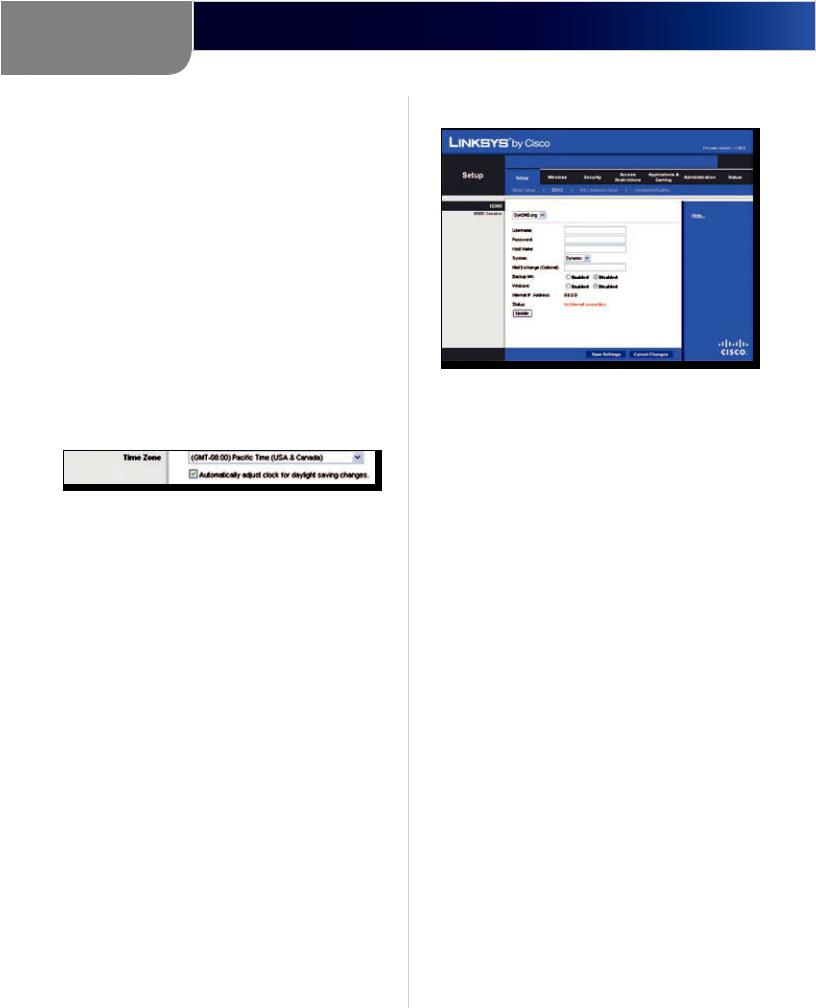
Chapter 3
Advanced Configuration
amount of time, in minutes, that the user will be “leased” this dynamic IP address. After the time is up, the user will be automatically assigned a new dynamic IP address. The default is 0 minutes, which means one day.
Static DNS 1-3 The Domain Name System (DNS) is how the Internet translates domain or website names into Internet addresses or URLs. Your ISP will provide you with at least one DNS Server IP Address. If you wish to use another, enter that IP Address in one of these fields. You can enter up to three DNS Server IP Addresses here. The Router will use these for quicker access to functioning DNS servers.
WINS The Windows Internet Naming Service (WINS) manages each PC’s interaction with the Internet. If you use a WINS server, enter that server’s IP Address here. Otherwise, leave this blank.
Time Setting
Time Zone Select the time zone in which your network functions from this drop-down menu. (You can even automatically adjust for daylight saving time.)
Time Setting
Click Save Settings to apply your changes, or click Cancel Changes to cancel your changes.
Setup > DDNS
The Router offers a Dynamic Domain Name System (DDNS) feature. DDNS lets you assign a fixed host and domain name to a dynamic Internet IP address. It is useful when you are hosting your own website, FTP server, or other server behind the Router.
Before you can use this feature, you need to sign up for DDNS service with a DDNS service provider, www.dyndns.org or www.TZO.com. If you do not want to use this feature, keep the default setting, Disabled.
DDNS
DDNS Service
If your DDNS service is provided by DynDNS.org, then select DynDNS.org from the drop-down menu. If your DDNS service is provided by TZO, then select TZO.com. The features available on the DDNS screen will vary, depending on which DDNS service provider you use.
DynDNS.org
Setup > DDNS > DynDNS
Username Enter the Username for your DDNS account. Password Enter the Password for your DDNS account.
Host Name The is the DDNS URL assigned by the DDNS service.
System Select the DynDNS service you use: Dynamic, Static, or Custom. The default selection is Dynamic.
Mail Exchange (Optional) Enter the address of your mail exchange server, so e-mails to your DynDNS address go to your mail server.
Backup MX This feature allows the mail exchange server to be a backup. To disable this feature, keep the default, Disabled. To enable the feature, select Enabled. If you are not sure which setting to select, keep the default,
Disabled.
Wildcard This setting enables or disables wildcards for your host. For example, if your DDNS address is myplace.dyndns.org and you enable wildcards, then x.myplace.dyndns.org will work as well (x is the wildcard). To disable wildcards, keep the default, Disabled. To enable wildcards, select Enabled. If you are not sure which setting to select, keep the default, Disabled.
Internet IP Address The Router’s Internet IP address is displayed here. Because it is dynamic, it will change.
Status The status of the DDNS service connection is displayed here.
Update To manually trigger an update, click this button.
Click Save Settings to apply your changes, or click Cancel Changes to cancel your changes.
Wireless-N Broadband Router |
11 |
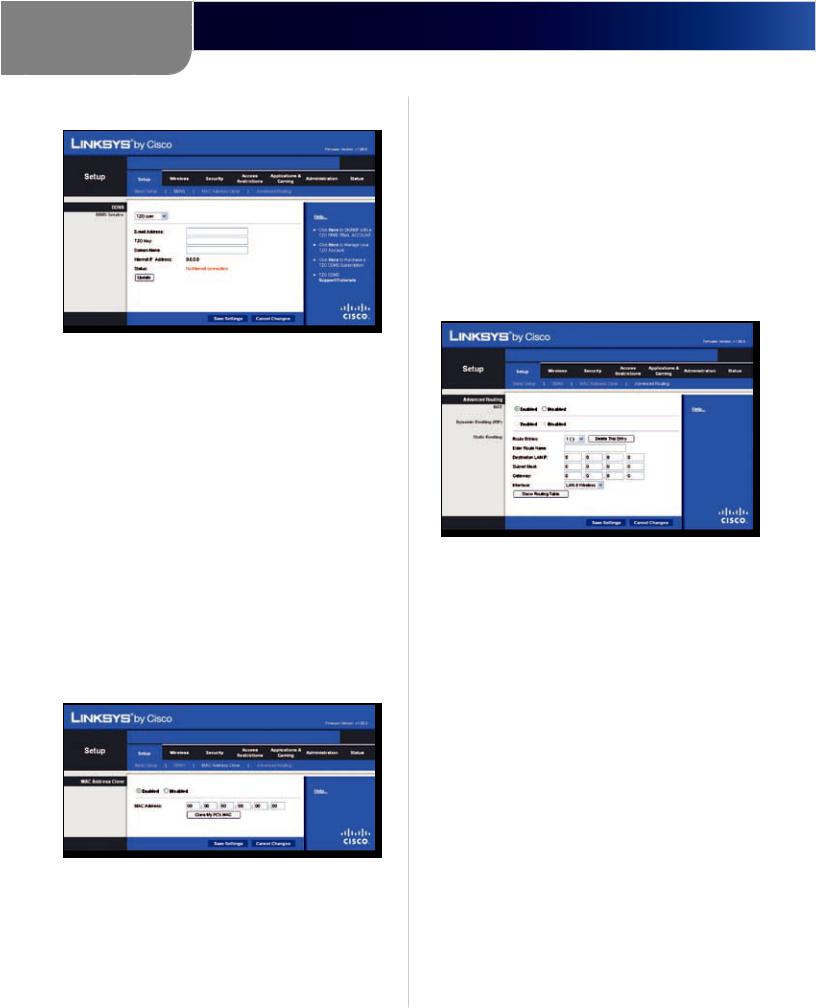
Chapter 3
Advanced Configuration
TZO.com
Setup > DDNS > TZO
E-mail Address, TZO Key, and Domain Name Enter the settings of the account you set up with TZO.
Internet IP Address The Router’s Internet IP address is displayed here. Because it is dynamic, it will change.
Status The status of the DDNS service connection is displayed here.
Update To manually trigger an update, click this button.
Click Save Settings to apply your changes, or click Cancel Changes to cancel your changes.
Setup > MAC Address Clone
A MAC address is a 12-digit code assigned to a unique piece of hardware for identification. Some ISPs will require you to register a MAC address in order to access the Internet. If you do not wish to re-register the MAC address with your ISP, you may assign the MAC address you have currently registered with your ISP to the Router with the MAC Address Clone feature.
Setup > MAC Address Clone
MAC Address Clone
Enabled/Disabled To have the MAC Address cloned, select Enabled.
MAC Address Enter the MAC Address registered with your ISP here.
Clone My PC’s MAC Click this button to clone the MAC address of the computer you are using.
Click Save Settings to apply your changes, or click Cancel Changes to cancel your changes.
Setup > Advanced Routing
This screen is used to set up the Router’s advanced functions. Operating Mode allows you to select the type(s) of advanced functions you use. Dynamic Routing automatically adjusts how packets travel on your network. Static Routing sets up a fixed route to another network destination.
Setup > Advanced Routing
Advanced Routing
NAT
Enabled/Disabled If this Router is hosting your network’s connection to the Internet, keep the default, Enabled. If another router exists on your network, select Disabled. When the NAT setting is disabled, dynamic routing will be enabled.
Dynamic Routing (RIP)
Enabled/Disabled This feature enables the Router to automatically adjust to physical changes in the network’s layoutandexchangeroutingtableswiththeotherrouter(s). The Router determines the network packets’ route based on the fewest number of hops between the source and the destination. When the NAT setting is enabled, the Dynamic Routing feature is automatically disabled. When the NAT setting is disabled, this feature is available. Select Enabled to use the Dynamic Routing feature.
Static Routing
A static route is a pre-determined pathway that network information must travel to reach a specific host or network. Enter the information described below to set up a new static route.
Wireless-N Broadband Router |
12 |

Chapter 3
Advanced Configuration
Route Entries To set up a static route between the Router and another network, select a number from the dropdown list. Click Delete This Entry to delete a static route.
Enter Route Name Enter a name for the Route here, using a maximum of 25 alphanumeric characters.
Destination LAN IP The Destination LAN IP is the address of the remote network or host to which you want to assign a static route.
Subnet Mask The Subnet Mask determines which portion of a Destination LAN IP address is the network portion, and which portion is the host portion.
Gateway This is the IP address of the gateway device that allows for contact between the Router and the remote network or host.
Interface This interface tells you whether the Destination IP Address is on the LAN &Wireless (Ethernet and wireless networks) or the WAN (Internet).
Click Show Routing Table to view the static routes you have already set up.
Advanced Routing > Routing Table
Routing Table
For each route, the Destination LAN IP address, Subnet Mask, Gateway, and Interface are displayed. Click Refresh to update the information. Click Close to exit this screen.
Click Save Settings to apply your changes, or click Cancel Changes to cancel your changes.
Wireless > Basic Wireless Settings
The basic settings for wireless networking are set on this screen.
There are two ways to configure the Router’s wireless network(s), manual and Wi-Fi Protected Setup.
Wi-Fi Protected Setup is a feature that makes it easy to set up your wireless network. If you have client devices, such as wireless adapters, that support Wi-Fi Protected Setup, then you can use Wi-Fi Protected Setup.
Configuration View To manually configure your wireless network, select Manual. Proceed to the “Basic Wireless Settings” section. To use Wi-Fi Protected Setup, select
Wi-Fi Protected Setup. Proceed to the “Wi-Fi Protected Setup” section.
Basic Wireless Settings
Wireless > Basic Wireless Settings (Manual Setup)
Network Mode From this drop-down menu, you can select the wireless standards running on your network. If you have Wireless-N, Wireless-G, and Wireless-B devices in your network, keep the default setting, Mixed. If you have only Wireless-G and Wireless-B devices in your network, select BG-Mixed. If you have only Wireless-N devices, select Wireless-N Only. If you have only Wireless-G devices, select Wireless-GOnly. If you have onlyWireless-B devices, select Wireless-B Only. If you do not have any wireless devices in your network, select Disabled.
Network Name (SSID) The SSID is the network name shared among all points in a wireless network. The SSID must be identical for all devices in the wireless network. It is case-sensitive and must not exceed 32 characters (use any of the characters on the keyboard). Make sure this setting is the same for all points in your wireless network. For added security, you should change the default SSID (linksys) to a unique name.
Channel Width Select Auto if you want the Router to automatically determine the proper channel width (20 MHz or 40 MHz) to use, or select 20 MHz only (default) if you want the Router to operate in Wireless-B and Wireless-G mode only. For best performance, Auto is recommended.
Channel Select a channel from 1 to 11, or Auto (default).
SSID Broadcast When wireless clients survey the local area for wireless networks to associate with, they will detect the SSID broadcast by the Router. To broadcast the Router’s SSID, keep the default setting, Enabled. If you do not want to broadcast the Router’s SSID, then select
Disabled.
Click Save Settings to apply your changes, or click Cancel Changes to cancel your changes.
Wireless-N Broadband Router |
13 |
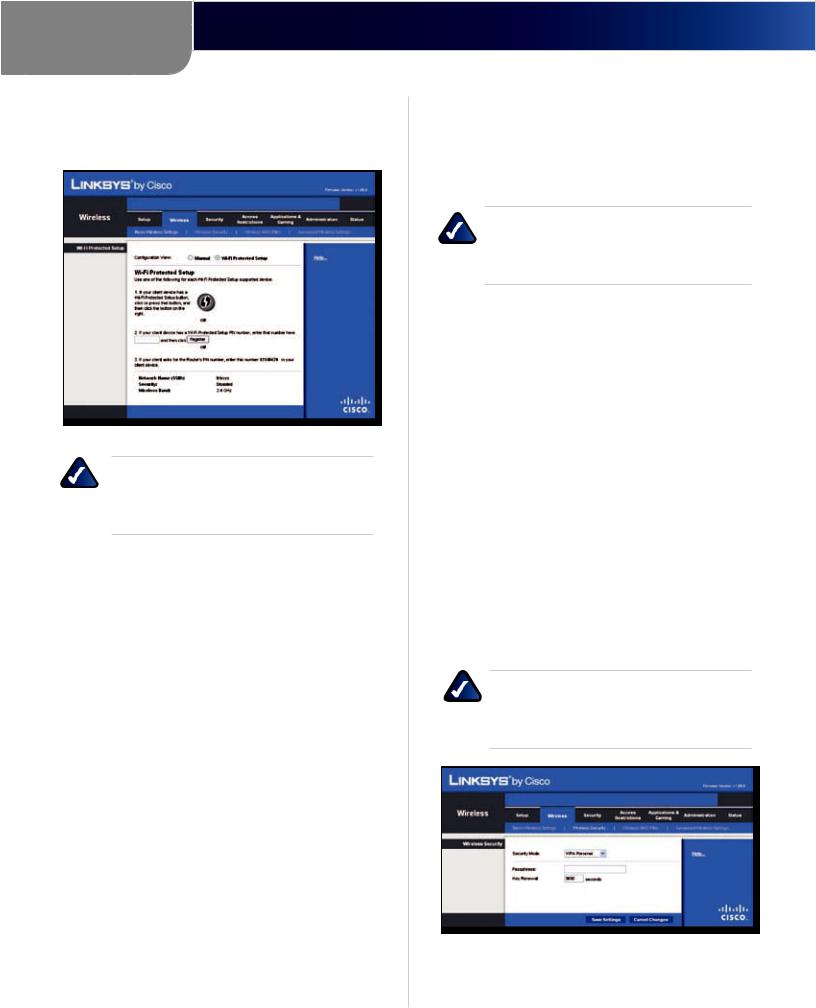
Chapter 3
Advanced Configuration
Wi-Fi Protected Setup
There are three methods available. Use the method that applies to the client device you are configuring.
Wireless > Basic Wireless Settings (Wi-Fi Protected Setup)
NOTE: Wi-Fi Protected Setup configures one client device at a time. Repeat the instructions for each client device that supports Wi-Fi Protected Setup.
Method #1
Use this method if your client device has a Wi-Fi Protected Setup button.
1.Click or press the Wi-Fi Protected Setup button on the client device.
2.Click the Wi Fi Protected Setup button on this screen.
3.After the client device has been configured, click OK. Then refer back to your client device or its documentation for further instructions.
Method #2
Use this method if your client device has a Wi-Fi Protected Setup PIN number.
1.Enter the PIN number in the field on this screen.
2.Click Register.
3.After the client device has been configured, click OK. Then refer back to your client device or its documentation for further instructions.
Method #3
Use this method if your client device asks for the Router’s PIN number.
1.Enter the PIN number listed on this screen. (It is also listed on the label on the bottom of the Router.)
2.After the client device has been configured, click OK. Then refer back to your client device or its documentation for further instructions.
The Wi-Fi Protected Setup Status, Network Name (SSID), Security, Encryption, and Passphrase are displayed at the bottom of the screen.
NOTE: If you have client devices that do not support Wi-Fi Protected Setup, note the wireless settings, and then manually configure those client devices.
Wireless > Wireless Security
The Wireless Security screen configures the security of your wireless network. There are six wireless security mode options supported by the Router: WPA Personal, WPA Enterprise, WPA2 Personal, WPA2 Enterprise, RADIUS, and WEP. (WPA stands for Wi-Fi Protected Access, which is a security standard stronger than WEP encryption. WEP stands for Wired Equivalent Privacy, while RADIUS stands for Remote Authentication Dial-In User Service.) These six are briefly discussed here. For detailed instructions on configuring wireless security for the Router, refer to “Chapter 2: Wireless Security.”
Wireless Security
Security Mode
Select the security method for your wireless network. If you do not want to use wireless security, keep the default,
Disabled.
WPA Personal
NOTE: If you are using WPA, always remember that each device in your wireless network MUST use the same WPA method and shared key, or else the network will not function properly.
Security Mode > WPA Personal
Passphrase Enter a Passphrase of 8-63 characters.
Wireless-N Broadband Router |
14 |
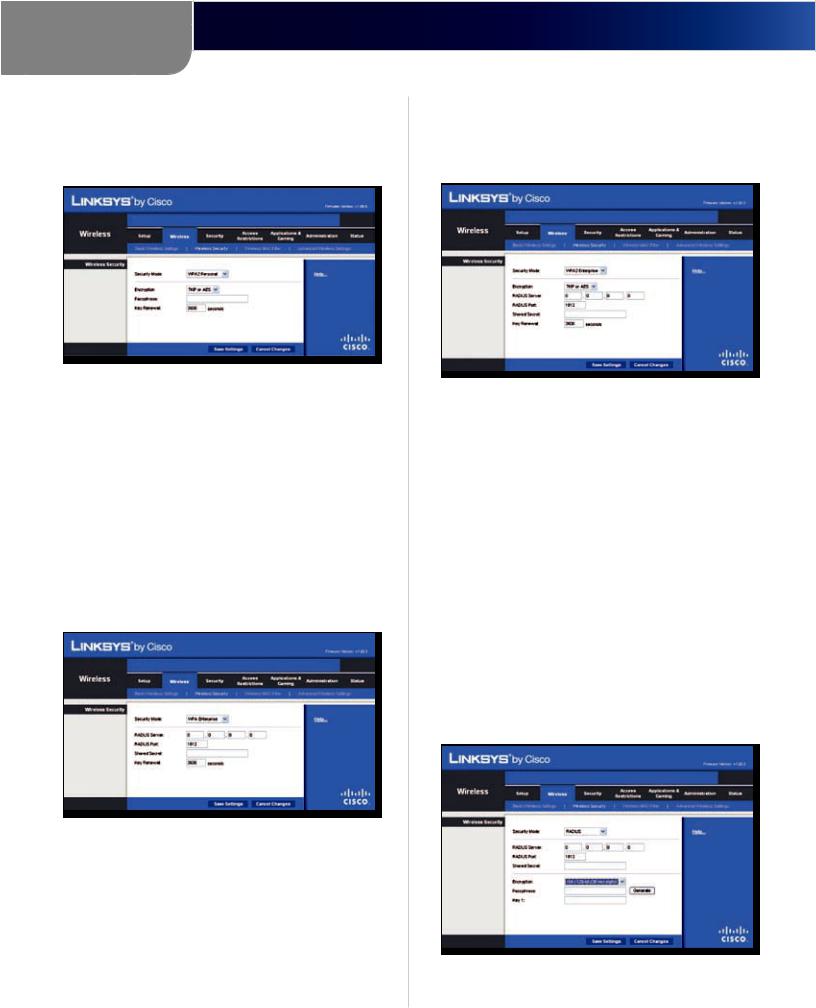
Chapter 3
Advanced Configuration
Key Renewal Enter a Key Renewal period, which instructs the Router how often it should change the encryption keys. The default Group Key Renewal period is 3600 seconds.
WPA2 Personal
Security Mode > WPA2 Personal
Encryption WPA2 supports two encryption methods, TKIP and AES, with dynamic encryption keys. Select the type of algorithm, AES or TKIP or AES. The default is TKIP or AES.
Passphrase Enter a Passphrase of 8-63 characters.
Key Renewal Enter a Key Renewal period, which instructs the Router how often it should change the encryption keys. The default Group Key Renewal period is 3600 seconds.
WPA Enterprise
This option features WPA used in coordination with a RADIUS server. (This should only be used when a RADIUS server is connected to the Router.)
Security Mode > WPA Enterprise
RADIUS Server Enter the IP Address of the RADIUS server.
RADIUS Port Enter the port number of the RADIUS server. The default value is 1812.
Shared Secret Enter the key shared between the Router and the server.
Key Renewal Enter a Key Renewal period, which instructs the Router how often it should change the encryption keys. The default Key Renewal period is 3600 seconds.
WPA2 Enterprise
This option features WPA2 used in coordination with a RADIUS server. (This should only be used when a RADIUS server is connected to the Router.)
Security Mode > WPA2 Enterprise
Encryption WPA2 supports two encryption methods, TKIP and AES, with dynamic encryption keys. Select the type of algorithm, AES or TKIP or AES. The default is TKIP or AES.
RADIUS Server Enter the IP Address of the RADIUS server.
RADIUS Port Enter the port number of the RADIUS server. The default value is 1812.
Shared Secret Enter the key shared between the Router and the server.
Key Renewal Enter a Key Renewal period, which instructs the Router how often it should change the encryption keys. The default Key Renewal period is 3600 seconds.
RADIUS
This option features WEP used in coordination with a RADIUS server. (This should only be used when a RADIUS server is connected to the Router.)
Security Mode > RADIUS
Wireless-N Broadband Router |
15 |
